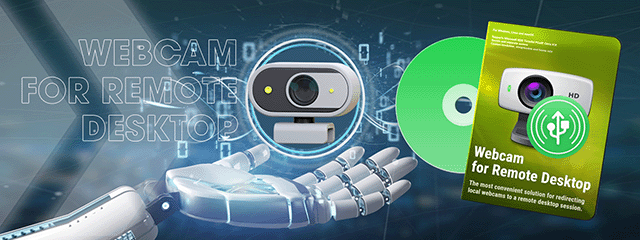
Webcam for Remote Desktop
When COVID-19 hit humanity, not everyone was prepared, and not just health-wise. Instead of working at offices, people switched to remote work and used tech such as remote-controlled webcams. Today, the trend of working from home or distant offices keeps growing, which means that key technologies like remote access webcams are required more than ever.
In this article, readers will discover the challenges of implementing remote desktop cameras, what solutions are available, and how to choose the right webcam with remote desktop access.
What Is A Remote Control Webcam And How Does It Work?
A remote desktop webcam allows users to capture and transmit video over the internet to another computer. This technology proves invaluable for remote work, whether the employees are located in a different city/country or work from home offices.
Such webcams with remote access enable online meetings and video conferencing, which allow individuals to avoid having to go to offices. This feature may save time and even money, especially if employees are located in different cities, and the company or business must pay for their flights.
These are two main remote desktop connectivity:
The first type of connectivity requires a direct USB connection between the webcam and the computer. That’s exactly what highfigure.net offers. Thanks to High Figure SoftWare, users can easily share remote desktop webcams and other crucial work devices.
The network connectivity or webcam over RDP (Remote Desktop Protocol) uses Wi-Fi or Ethernet. This solution provides flexibility, as you can place the camera anywhere. This software often uses redirection that allows a remote computer to access a local webcam through a network connection.
Simply put, a webcam on someone’s computer can be accessible by another user (with permission). This peculiarity of RDP webcams improves the easy remote integration of devices.
Webcam for remote desktop software also uses virtual drivers. For example, if a company buys webcam software, it will be compatible with other remote work software used by employees.
As for the quality of video and stability of connection, remote cameras often use compression techniques. Typically, these techniques include H.264 and MJPEG. They reduce video file sizes without compromising quality.
Such a device is quite simple to connect. You must first be able to use a webcam. It’s possible to connect it via USB or have it integrated into a laptop or display:
Once connected, you may attend conferences or meetings from an RDP session by using your remote desktop webcam. Moreover, you can use USB Network Gate. It virtualizes real devices and makes them accessible via USB ports on your computer via an RDP connection.
On a computer with a physical connection to the camera you wish to access, download, and install USB Network Gate to use the webcam during a remote desktop session. Launch the USB Network Gate on both the client and server computers. By navigating to the Local USB Devices page in USB Network Gate and choosing Share, you can select the preferred USB webcam on the server. Go to the USB Network Gate’s “Remote Devices” tab, select the necessary USB webcam on the server, and press the “Connect” button.
Challenges Of Implementing Remote Access Webcams
While convenient and offers numerous advantages for remote work, remote control webcams create some challenges. On the bright side, it’s easy to overcome these challenges when using high-quality software provided by Highfigure. But first, let’s figure out what the common issues are.
One significant difficulty involves video quality and resolution. Simply put, if the internet connection is slow or unstable, the video may become blurry or freeze, making it challenging for team members to see and understand each other clearly.
Connection stability is another problem, which also mainly depends on internet stability. The entire remote work relies heavily on internet connections, and any disruptions can result in dropped calls or delays in video streaming. This inconsistency can cause frustration and disrupt the flow of virtual meetings.
Another common issue is not choosing the right software. As a result, the remote desktop camera software that a company purchased is incompatible. The problem becomes evident when video transmission isn’t synchronized with audio. Thus, employees experience delays, and this can impact their work. Further in the article, we will explain how to choose the right webcam software so that you won’t face these challenges.
However, the biggest issue that most people fear is security. Unauthorized access to webcams can compromise privacy and confidentiality. Businesses can choose quality software and regularly install updates. For example, they can purchase High Figure software that regularly releases updates to address safety concerns. Moreover, companies can additionally configure firewalls and regularly change passwords for remote desktop camera access.
How To Choose A Remote Access Webcam?
When buying a webcam on remote desktop software, choosing the right one is important. You can consider Highfigure products since they are convenient to use, have user-friendly interfaces, and are safe. However, let’s break down what factors to consider when choosing the right webcam software:
These factors should help you choose the right webcam software. If having issues or questions, contact support.
Without remote webcam software, numerous businesses wouldn’t be as effective. Luckily, modern companies can purchase and install webcam software from High Figure. Our solutions are safe, provide high-quality video, and are compatible with all popular platforms for remote work.